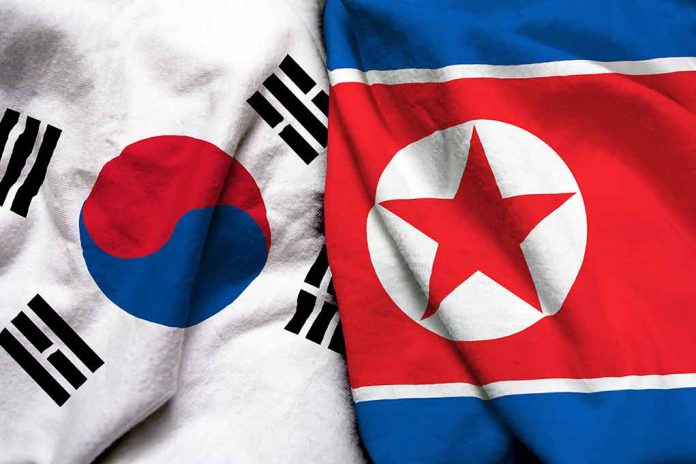
President Trump is considering a major strategic shift by potentially withdrawing thousands of American troops from South Korea, while Kim Jong Un’s military competence faces serious questions after a new warship capsized during its launch.
Key Takeaways
- The Trump administration is reviewing a potential withdrawal of 4,500 U.S. troops from South Korea, possibly relocating them to other Indo-Pacific locations like Guam
- South Korea’s Defense Ministry insists no official talks on troop withdrawals have taken place and emphasized the importance of the alliance
- North Korea suffered an embarrassing military setback when a newly constructed warship capsized during its launch, with Kim Jong Un labeling it a “criminal error”
- The potential troop reduction comes amid President Trump’s longstanding concerns about allies not paying their fair share for defense
- The dual developments highlight shifting power dynamics in the region as the U.S. recalibrates its strategic posture
Potential U.S. Troop Withdrawal from South Korea
A significant shift in America’s military posture in Asia may be on the horizon as the Trump administration considers withdrawing thousands of troops from South Korea. According to a Wall Street Journal report, White House officials are contemplating the relocation of approximately 4,500 American military personnel from South Korea to other areas in the Indo-Pacific region, including Guam. This potential drawdown would represent nearly 16% of the current 28,500 U.S. troops stationed on the Korean Peninsula as part of America’s decades-long security commitment to South Korea.
“As the core strength of the South Korea-U.S. alliance, the USFK, alongside our military, has contributed to the peace and stability of the Korean Peninsula and in the region by maintaining a firm combined defense posture and deterring North Korea’s invasion and provocation,” said South Korean Defense Ministry.
South Korean officials have quickly moved to downplay these reports, with the Defense Ministry stating that no formal discussions on troop withdrawals have occurred with the Pentagon. Despite these assurances, the proposal is reportedly part of a broader informal policy review on North Korea that has not yet reached President Trump’s desk for consideration. Such a significant reduction in U.S. military presence could raise serious concerns among regional allies about America’s commitment to security in Asia, especially at a time when North Korea continues its nuclear weapons development and China expands its military influence.
North Korea’s Military Embarrassment
While the U.S. contemplates its military positioning, North Korea suffered a significant and embarrassing setback to its naval ambitions. In a humiliating display that raises questions about North Korea’s military capabilities, a newly constructed warship capsized during its launch ceremony, reportedly in front of Kim Jong Un himself. The incident has apparently infuriated the North Korean leader, who denounced the failure as a “criminal act” resulting from negligence and poor construction standards. This military mishap comes at a time when North Korea has been attempting to project strength and technological advancement.
The timing of the warship failure coincides with heightened tensions on the Korean Peninsula, where North Korea has continued to develop its nuclear arsenal and missile capabilities despite international sanctions. The embarrassing incident provides a stark contrast to the regime’s carefully crafted image of military prowess and technological achievement. Military analysts suggest this failure may indicate deeper systemic issues within North Korea’s defense industrial base, including potential material shortages, technical limitations, and quality control problems that persist despite the regime’s prioritization of military development.
Trump’s Strategic Recalibration
President Trump’s consideration of troop withdrawals aligns with his longstanding position that American allies must contribute more to their own defense. During his first term, President Trump characterized the U.S.-South Korea alliance as “unfair” and threatened to withdraw American forces unless Seoul increased its financial contributions to support the U.S. military presence. The current deliberations appear to continue this approach of requiring allies to take greater responsibility for their security while the U.S. repositions its forces to address broader regional challenges, particularly the growing military influence of China.
“We will continue to cooperate with the U.S. side to advance in such a direction,” shared South Korean Defense Ministry.
The Pentagon has thus far declined to comment on the reported troop withdrawal considerations, maintaining its typical silence on policy matters still under review. However, military strategists note that any significant reduction in U.S. forces could alter the security calculus in Northeast Asia at a critical time. With North Korea continuing its weapons development despite its recent naval embarrassment, and China expanding its influence throughout the region, American allies including South Korea and Japan are watching closely to see how President Trump will ultimately balance his desire for allies to increase their defense spending with America’s strategic interests in maintaining stability in this volatile region.









